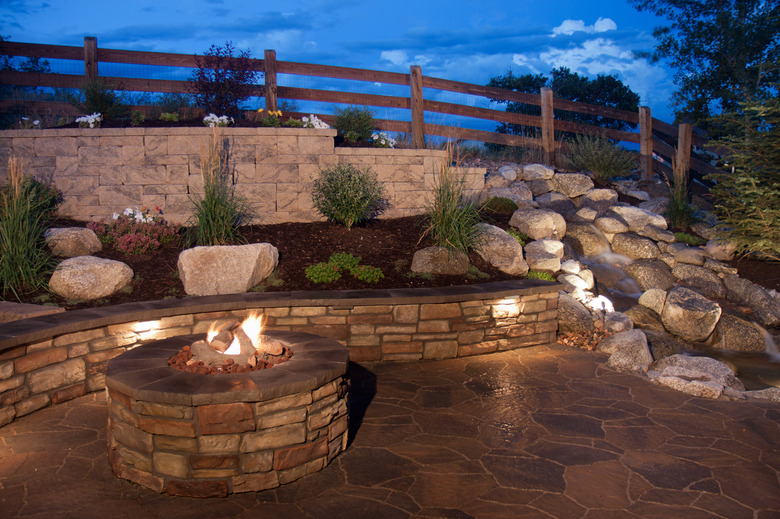Easy DIY Repairs For Flagstone Patios
We may receive a commission on purchases made from links.
Whether you use it for dining outdoors or sitting by the fire pit, a flagstone patio adds a sense of elegance (and sturdiness) to your outdoor living space and your landscaping. But within a handful of years, even a professionally installed flagstone patio may need a few repairs. Thankfully, most maintenance, such as mortar or individual stone replacement, is simple enough for a weekend DIY project for even a brand new homeowner. Regardless of the nature of your stone patio repair project, it's wise to invest in knee pads or a kneeler, as much of this home improvement project requires getting up close and personal with the pavers.
Reasons Why Flagstone Patios Need Repair
Reasons Why Flagstone Patios Need Repair
Because your stone patio is exposed to the elements, it likely won't stay pristine forever due to harsh winters, summer rain storms and damaging winds, which can wreak havoc on this area of your outdoor living space. For stones set in sand, too much sand or a drainage issue could cause the patio to sink in some areas. Frost might cause mortared flagstone to crack, or cause the mortar itself to crack over time. Flagstone might also chip or start to crumble due to a sharp blow from a heavy dropped object, for instance.
Repairing Sunken Spots on Flagstone Patios
Repairing Sunken Spots on Flagstone Patios
If your flagstone patio is set in sand rather than mortared in place, there's a chance that some sections will be susceptible to sinking over time due to drainage issues or too much sand beneath the pavers. Sunken spots could make the patio less enjoyable, as the deep spots may hold water after rain. Patio furniture placed in the area might wobble, and in extreme situations, the off-kilter pavers could crack or cause tripping when an unsuspecting guest walks over that area.
Repairing sunken spots requires removing the affected flagstones, including some that are level in the area immediately around the indentation. Take a picture of the area before removing anything so you'll know where to place each stone afterward.
To remove the first stubborn flagstones, use a straight-edged garden tool, screwdrivers, metal putty knives or paint scrapers to help pry free the stones. Once the stones are out, scoop all the sand out of the area that's sunken but leave the sand in place in areas where the stones were level, as this "good" area shows you how deep the sand should be when you fill in the sunken area.
Fill the depression partway with compactible gravel or crushed stone, keeping it lower than the surrounding level sand area. Tamp down the gravel and then add sand atop the gravel, smoothing it out with a trowel or the back end of a garden rake until the new sand is level with the surrounding already-level sand. Place the flagstone pieces back in place, doing your best to keep the spacing the same as with the surrounding pavers. Tamp down the stones with a hand tamper.
In dry weather, fill the gaps between stones with polymeric sand, sweeping excess off the tops of the stones, tamping down the sand with a tool handle and ensuring the sand level between pavers is a little lower than the tops of the pavers. Lightly sprinkle the sand with water to cause it to set like cement and then wait several days (or as recommended on the sand packaging) before walking over the repaired area.
Polymeric Sand Solutions
Polymeric Sand Solutions
Over time, sand or other loose filler material used between flagstone pavers washes out. Weeds eventually grow between pavers, and the simple act of weeding also removes some of the filler you've previously placed between pavers. Polymeric sand, which is a special blend of fine sand and bonding additives, is the solution to this type of problem.
The bonding additives in polymeric sand cause sand to harden when wet, much the way concrete powder hardens after mixing it with water. When used to fill gaps between pavers in a new or old flagstone patio, polymeric sand helps keep the pavers in place while inhibiting weed growth between pavers. It's easier to work with than a mortar or cement mix, as you brush the dry sand into place and then water it rather than stirring in water first and applying the mixture with a trowel or shovel.
Polymeric sand is a bit finicky, however. It works best if used to fill the entire depth of the gap between stones, which means you'll have to dig out every bit of old filler material in areas that need repairs. A pressure washer comes in handy for removing all the old sand, but be sure to wear goggles and protective clothing, as this method is quite messy. If you use a pressure washer or if it has rained recently, you'll have to wait until the nearby flagstone and the ground between stones is completely dry; otherwise, the polymeric sand may stain.
Removing Broken Flagstone
Removing Broken Flagstone
In some situations, flagstone breaks or crumbles, causing the patio and overall landscaping to look a bit unkempt. Weeds may grow between cracks, requiring more attention to keep the area free of weeds. If sandset flagstone breaks into two pieces that seem to be in fairly good condition and are large enough to work with, you may be able to simply reposition them and fill the new gap between them with sand or polymeric sand. In other situations, you may have to replace several flagstone pieces entirely, especially if the flagstone is mortared in place.
For a mortared patio, use a hammer and a stone chisel to chip out the mortar between a damaged stone and its surrounding undamaged stones. In some cases, you may be able to wedge a chisel or screwdriver into the crack in the damaged stone and pry it out. If the stone is strongly cemented in place, you may have to break the damaged stone into smaller pieces with a hefty mallet before successfully removing it. Chisel out all the remaining bits of broken stone, mortar and adhesive. Remove as much dirt and debris as possible by scooping it out or by using a leaf blower or air compressor (be sure to wear goggles to protect your eyes).
Once the hole is free of debris, test fit the new flagstone piece or pieces, spacing them as desired to ensure the gaps around each stone are approximately the same size as those in the rest of the patio. If everything fits as desired, you're free to replace the stones using mortar or masonry adhesive and joint-repair adhesive.
Breaking Flagstone to Size
Breaking Flagstone to Size
If the new flagstones pieces are too large to use to repair your patio, you'll have to cut them to a size that works. Choose flagstone that matches your existing stone in appearance and in thickness. When cutting flagstone, aim for relatively straight, simple lines for a better chance at success. For just a few stones, a hammer and a stone chisel are enough to do the trick, while larger projects require power tools. In either case, wear eye protection and a dust mask.
Mark the desired cut line in chalk. Starting at one end, tap along the line with the hammer and chisel. The goal is to notch away a little at a time with patience and not with brute force, working your way down the line across the flagstone face. Once you've completed one pass, go over the notch again, making it deeper. Eventually, the stone snaps along the scored line either while you're tapping the chisel or with a blow from a mallet on the "scrap" side of the score line.
For moderate jobs, a circular saw fitted with a diamond masonry blade does the trick. With the stone securely clamped to a work table, let the weight of the saw cut the notch slowly, working your way across the flagstone to create a shallow groove rather than trying to cut straight through in one pass. As with a hammer and chisel, the goal is to create a score line. Once the line is halfway through the flagstone, switch to a hammer and chisel to break the stone along the groove.
Mortar New Stones in Place
Mortar New Stones in Place
Mortar is a good option if you are repairing large areas of the patio or if you prefer to stick with one product rather than using a construction adhesive and a joint-repair adhesive. As with any method of setting the new stone in place, the hole for each stone must be free of any dust and debris.
Dry fit your new stones to determine the best layout and to see how thick the mortar needs to be to hold down the stones. This mortar thickness is the difference in height between the new loose stone and the old stone already in place. Mix mortar according to the package directions and scoop a trowelful or so into each stone hole, smoothing out the mortar so the space is flat and even with the surrounding dry mortar. This ensures that the new stone sits level with its neighbors.
Set each new stone in place and push down gently using a level or straightedge placed across neighboring stones to ensure it is flush with the surrounding surfaces. Let the mortar cure for 24 hours or as directed. Mix a fresh batch of mortar to use between stones. Scoop the new mortar into place between stones using the side of a trowel or by putting mortar into a heavy-duty plastic bag with one bottom corner cut off, squeezing the mortar through the cutout into the joint around the stone. Gently push down and level the mortar with a narrow trowel or jointer.
Keep the mortar level with the surrounding dry mortar, removing any excess. Clean the flagstone faces with a damp sponge to remove excess mortar, wait 90 minutes or so and then shape the mortar as desired with a tuck-pointing trowel. Afterward, brush over it with a stiff-bristled paintbrush to smooth things out. Wait at least 24 hours before walking over the repaired areas of your patio.
DIY Fix for Loose Flagstone
DIY Fix for Loose Flagstone
If a piece of mortared flagstone works its way loose, you don't necessarily have to use mortar to secure the stone. Masonry or paver adhesive and mortar joint repair adhesive come in handy for a simple DIY fix for a few loose pavers.
Step 1: Remove the Loose Flagstone
Pull up the loose stones with a pry bar if they don't easily come free without tools.
Step 2: Remove Dirt and Mortar
Scrub off dirt and mortar from the freed stones using a stiff synthetic brush, a wire brush or even a thick, metal paint scraper for tough debris stuck to the bottom of the flagstone. Compressed air and a brush come in handy for removing the last bits of dust.
Step 3: Apply Masonry Adhesive
A caulk gun outfitted with a tube of masonry adhesive glues the stone back into place. Apply beads of adhesive about 1 inch apart or as directed on the product label over the bottom side of the flagstone. Flatten the beads by running a flat jointer or another flat trowel-type tool over them.
Step 4: Apply Joint-Repair Adhesive
Before setting down the flagstone, squirt a bead of mortar joint-repair adhesive around the perimeter of the stone. Since this leaves nowhere to grab without getting your hands or gloves messy, you can leave a gap on two of the sides for grip.
Step 5: Set the Flagstone
Set the flagstone in its original position on the stone patio. Apply a bit more joint-repair adhesive along the perimeter if you skipped some spots or if it needs more to fill in the gaps between flagstones. This is a good time to fill in any other areas on the patio that need more mortar or adhesive between stones.
Step 6: Finish Using the Joint-Repair Adhesive
Smooth out the wet joint-repair mortar adhesive using the flat jointer or a convex or rat-tail jointer if you need to recreate the look of a somewhat concave mortar joint. Wipe away excess with a slightly damp sponge or as recommended by the product manufacturer. Sprinkle stone dust and fine particles mixed with sand over the wet adhesive and then allow it to dry a day or so before brushing away any excess. Wait at least several days or as long as is recommended on the masonry adhesive packaging before walking on the repaired areas of the patio.


